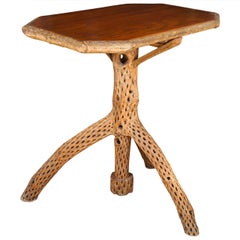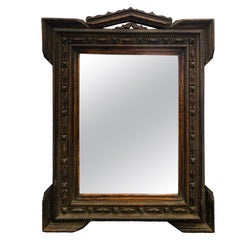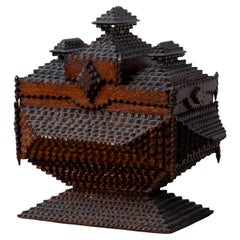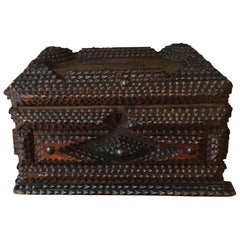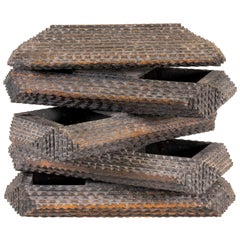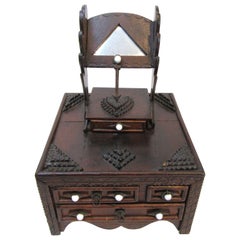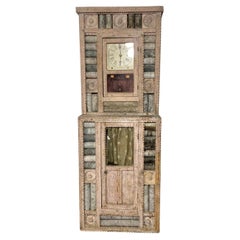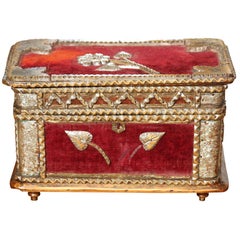Tramp Art Furniture
Vintage 1930s American Mission Gueridon
Wood
Antique Early 1900s French Folk Art Wall Mirrors
Mirror, Wood
Antique 1890s Folk Art Outsider and Self Taught Art
Velvet, Wood
Antique 1890s French Folk Art More Folk Art
Wood
20th Century Unknown Folk Art Nautical Objects
Wood
1990s American Sculptures and Carvings
Wood
Antique Late 19th Century American Folk Art Outsider and Self Taught Art
Wood
Antique 1890s American Folk Art Antiquities
Stone, Granite
Early 20th Century American Outsider and Self Taught Art
Wood, Fabric, Mirror
Antique Late 19th Century American Sculptures and Carvings
Wood
Early 20th Century American Folk Art Antiquities
Wood
Antique Early 1900s American Folk Art Native American Objects
Pine
Antique 19th Century North American Outsider and Self Taught Art
Wood
Vintage 1920s French Folk Art Outsider and Self Taught Art
Reclaimed Wood
Vintage 1950s American American Craftsman Sculptures and Carvings
Wood
Late 20th Century American Outsider and Self Taught Art
Wood
Antique 19th Century English Folk Art Antiquities
Metal
20th Century American Folk Art Outsider and Self Taught Art
Wood
20th Century American American Craftsman Desks
Wood
Antique Late 19th Century Austrian Mirrors
Mirror, Softwood
Vintage 1940s American Outsider and Self Taught Art
Wood, Mirror
Mid-20th Century Folk Art Wall Mirrors
Silver Leaf
Antique Late 19th Century German Folk Art Sculptures and Carvings
Wood
Antique Late 19th Century German Folk Art Sculptures and Carvings
Mirror, Wood
Antique Late 19th Century American Folk Art Decorative Boxes
Textile, Wood
Antique 19th Century American Country Decorative Boxes
Wood
Early 20th Century American Folk Art Decorative Boxes
Velvet, Wood
Antique 19th Century English Folk Art Jewelry Boxes
Fruitwood
Antique Late 19th Century Folk Art Decorative Boxes
Wood
Antique 1890s American Folk Art Sculptures and Carvings
Wood
Vintage 1930s American Folk Art Side Tables
Wood
Antique 19th Century American Folk Art Cupboards
Wood
Antique Mid-19th Century German Folk Art Sculptures and Carvings
Brass, Metal
Early 20th Century European Folk Art Decorative Boxes
Mirror, Wood
Vintage 1930s American Folk Art Religious Items
Wood
Vintage 1910s Italian Arts and Crafts Cigar Boxes and Humidors
Wood
Vintage 1940s European Folk Art Decorative Boxes
Wood
Early 20th Century American Folk Art Desks
Wood
Vintage 1920s Belgian Folk Art Decorative Boxes
Glass, Wood
Early 20th Century European Folk Art Decorative Boxes
Wood
Antique Late 19th Century German Black Forest Cabinets
Wood
Late 20th Century American Rustic Games
Wood
Antique 1870s German Country Decorative Boxes
Wood
Mid-20th Century American Folk Art Coat Racks and Stands
Shell, Wood
Antique 19th Century American Rustic Magazine Racks and Stands
Horn
Antique Early 1900s Austrian Folk Art Religious Items
Wood
20th Century Wall Mirrors
Resin, Foam
Antique Late 19th Century French Rustic Wall Mirrors
Wood
Vintage 1930s Unknown Folk Art Pedestals
Palmwood
Antique 1830s Austrian Folk Art Wall Mirrors
Softwood, Spruce
Mid-20th Century Polish Folk Art Decorative Boxes
Wood
Mid-20th Century Unknown Folk Art Figurative Sculptures
Wood
Antique 19th Century French Rustic Wall Mirrors
Wood
Antique Late 19th Century French Wall Mirrors
Mirror
20th Century Czech Decorative Art
Paper
Antique 1890s Austrian Folk Art Decorative Boxes
Brass
Antique 1880s Austrian Folk Art Decorative Boxes
Brass
Early 20th Century French Folk Art Wall Mirrors
Mirror, Wood
Early 20th Century French Folk Art Wall Mirrors
Mirror, Wood
Early 20th Century French Art Nouveau Decorative Boxes
Brass
- 1
- ...
Tramp Art Furniture For Sale on 1stDibs
How Much is a Tramp Art Furniture?
- When was tramp art created?1 Answer1stDibs ExpertApril 5, 2022Tramp art is art made from discarded or ‘found’ wood materials, such as shipping pallets or boxes that products such as cigars or fruit came in. Tramp art is crafted using a method of carving called chip carving. It first began to take off in the late 1800s. Shop an array of antique tramp art from top sellers on 1stDibs.
- What is considered tramp art?1 Answer1stDibs ExpertApril 5, 2022Tramp art refers to a type of folk art where wood furniture and decorative objects were made from found items. Often, artisans working in the style used shipping crates and cigar boxes as raw materials. They cut the wood apart and created geometric patterns by layering the pieces. Most tramp art dates back to the period between 1870 and the late 1940s. Find a collection of tramp art on 1stDibs.
- Why do they call it tramp art?1 Answer1stDibs ExpertApril 5, 2022Tramp art is called thusly because artists made it from everyday discarded items, such as pallets, cigar boxes and other sources of found wood. This art form was popularly crafted from 1870 to 1940. Browse a collection of authentic tramp art on 1stDibs.
- What is Art Nouveau furniture?1 Answer1stDibs ExpertAugust 15, 2019
Art Nouveau furniture was a style of furniture that emerged at the end of the 19th century and was characterized by its complex curved lines. The curved details in the furniture were typically carved by hand and finished with lacquer. The unmistakable gloss that is associated with Art Nouveau comes from the thick coat of varnish applied to the furniture as the final step of the production process.
- 1stDibs ExpertNovember 4, 2024To identify Arts and Crafts furniture, first see if you can locate a maker's mark on your piece. By researching any marks using trusted online resources, you can determine who produced your piece and find out if the maker was linked with the Arts and Crafts movement. Some notable makers associated with the style include William Morris and Philip Webb. If you can't find a maker's mark, examine the details of your piece. The Arts and Crafts movement began as a reaction to mass production, highlighting craftsmanship, raw materials and simple design. Due to its handcrafted origins, Arts and Crafts furniture often displays tool marks and slight variations in carvings and details. Pieces so regular that they seem machine-made are less likely to be Arts and Crafts furniture. Other common characteristics of Arts and Crafts pieces include inlaid and carved details and natural wood materials with visible grains. Chairs often feature reclining or angled backs and armrests. If you'd like assistance determining whether a particular piece is Arts and Crafts, consider consulting a certified appraiser or experienced antique dealer. On 1stDibs, explore a range of Arts and Crafts furniture.
- 1stDibs ExpertNovember 4, 2024To identify Art Nouveau furniture, first try to locate a maker's mark on the piece. You can then use it to research the maker with the help of information published in trusted online resources. Some makers, such as Charles Rennie Mackintosh, Louis Majorelle and Émile Gallé, are well-known for their Art Nouveau furnishings. If you determine that a maker identified with Art Nouveau produced your piece, it likely reflects the movement's characteristics, especially if it was made during the late 19th or early 20th centuries. You can also look for common features of Art Nouveau furniture, such as sinuous, organic and flowing lines; forms that mimic flowers and plant life; decorative inlays and ornate carvings of natural-world motifs such as insects and animals and the use of hardwoods such as oak, mahogany and rosewood. A certified appraiser or knowledgeable antique dealer can aid you with the identification process. Shop a diverse assortment of Art Nouveau furniture on 1stDibs.
- 1stDibs ExpertAugust 15, 2019
Art Deco style furniture appeared right before the start of World War I and is defined by sharp lines, vibrant colors and bold patterns. Heavily influenced by geometry, Art Deco furniture was born out of the Cubism movement.
- 1stDibs ExpertAugust 15, 2024To identify Arts and Crafts furniture, look for characteristics that are hallmarks of the style. The Arts and Crafts movement began as a reaction to mass production, highlighting craftsmanship, raw materials and simple design. Makers working in this style placed an emphasis on natural motifs and adorned their pieces with simple flourishes like mosaics and carvings. This work is characterized by plain construction that showcases the hand of the artisan. Arts and Crafts furniture was often built from sturdy woods like oak and mahogany while featuring details such as inlaid metal, tooled leather and ceramic tiles. The style in the United States was led by Gustav Stickley, whose clean-lined chairs and benches showcased the grain of the wood, and furniture maker Charles Rohlfs, who was informed by international influences like East Asian and French Art Nouveau design. If you need help identifying the style of your furniture, a certified appraiser or knowledgeable antique dealer can be of assistance. Find a diverse assortment of Arts and Crafts furniture on 1stDibs.
- 1stDibs ExpertFebruary 27, 2024To identify Art Deco furniture, first look for maker's markings in inconspicuous areas. Once you've found them, use trusted online resources to research the manufacturer and determine whether they were active during the Art Deco era, which spanned from the 1920s through the 1930s. You can also look for classic characteristics of Art Deco furniture, such as bold geometric lines and forms, intricate floral motifs, metal accents, mirrored finishes and fine materials such as shagreen, marble, mahogany wood, zebra wood, ebony, exotic animal hides, onyx and mother-of-pearl. A certified appraiser or knowledgeable antiques dealer can also assist you with making identifications. Shop a collection of Art Deco furniture on 1stDibs.
- How was Art Deco furniture made?1 Answer1stDibs ExpertApril 5, 2022Art Deco furniture was largely made by hand. Crafters often employed exotic hardwood like zebra wood, rosewood and Macassar ebony. Many pieces had a polished Japanese lacquer finish, which gave a high-gloss shine to the wood. On 1stDibs, shop a variety of Art Deco furniture.
- 1stDibs ExpertFebruary 27, 2024What Art Deco furniture looks like can vary from piece to piece, but there are some characteristics that help define the style. During the 1920s and ’30s, manufacturers often created furniture with bold geometric lines and forms as well as intricate floral motifs. Materials tended to be luxurious and included shagreen and marble as well as exotic woods such as mahogany, ebony and zebra wood. Many pieces feature luxe details like gleaming metal accents, shimmering mirrored finishes and embellishments made from exotic animal hide and inlays of mother-of-pearl or ivory. Explore a wide range of Art Deco furniture on 1stDibs.
- 1stDibs ExpertApril 5, 2022
The main features of Art Deco furniture are bold geometric lines and forms, and an integration of expensive materials such as shagreen or marble as well as exotic woods such as mahogany, ebony and zebra wood.
The Art Deco era made an indelible mark on all fields of design throughout the 1920s and ’30s, and while the period yielded a range of stylistically diverse furnishings, interiors and objects, collectors will typically find the period’s desks, tables and chairs embellished with metal accents, animal hides, ivory or mother-of-pearl inlays and shimmering mirrored finishes.
Widely known designers associated with the Art Deco style include Émile-Jacques Ruhlmann, Eileen Gray, Maurice Dufrêne, Paul Follot and Jules Leleu. The term Art Deco derives from the name of a large decorative arts exhibition held in Paris in 1925. “Art Deco design” is often used broadly, to describe the work of creators in associated or ancillary styles. This is particularly true of American Art Deco, which is also called Streamline Moderne or Machine Age design. (Streamline Moderne, sometimes known as Art Moderne, was a phenomenon largely of the 1930s, post–Art Nouveau.)
Shop a collection of Art Deco furniture from some of the world’s top sellers on 1stDibs.
